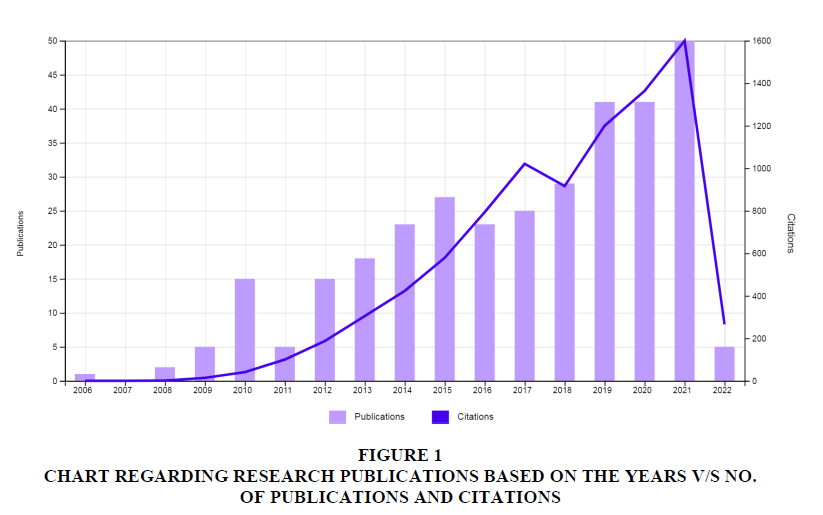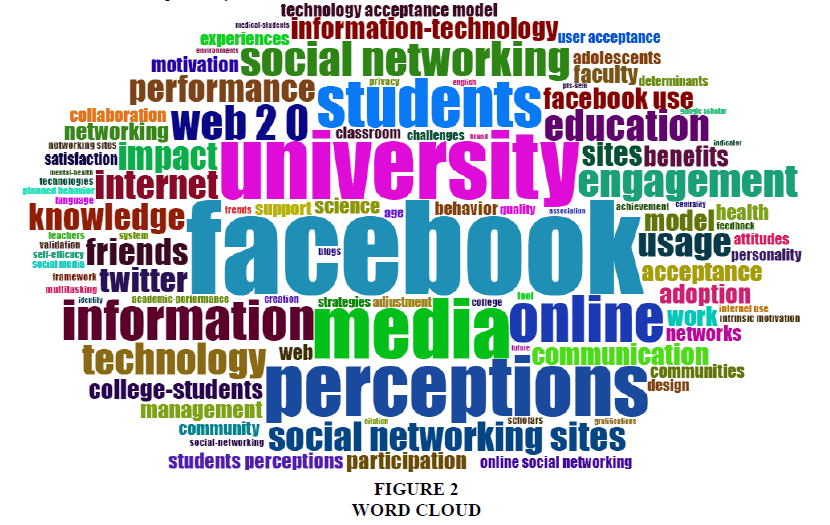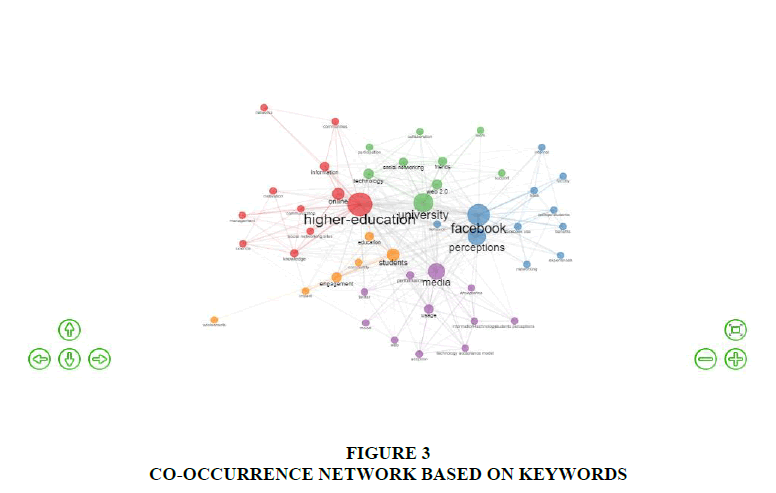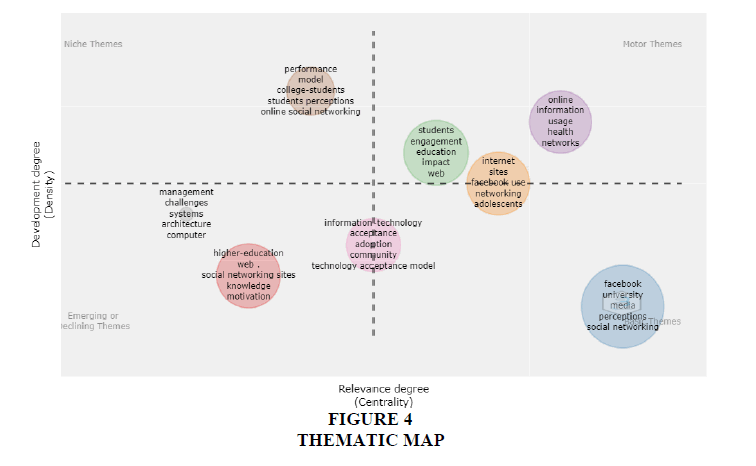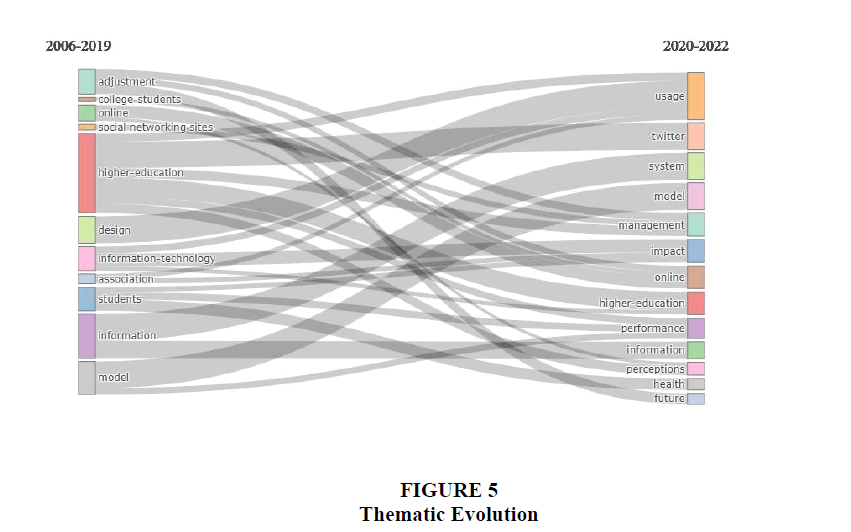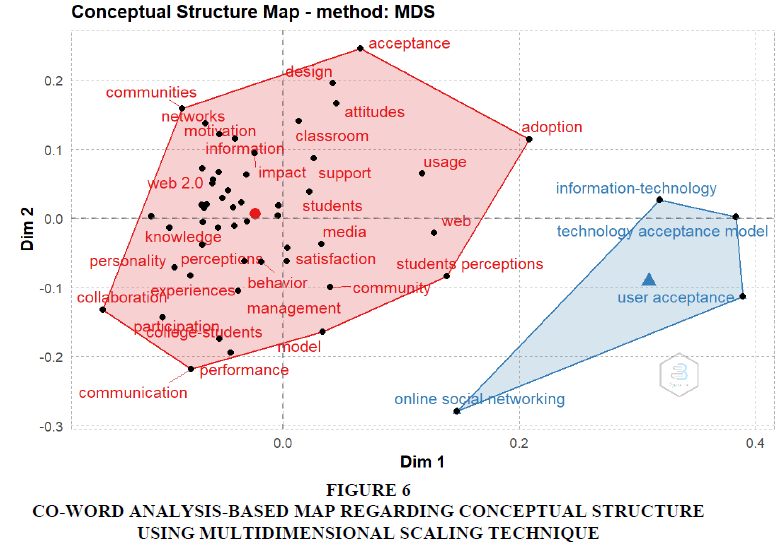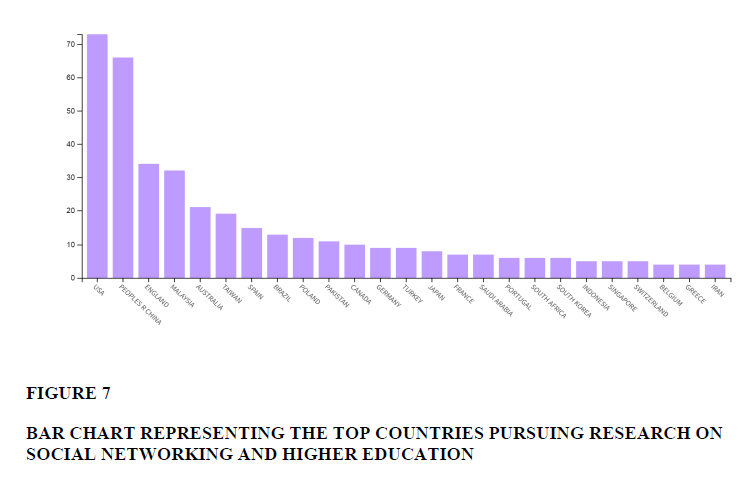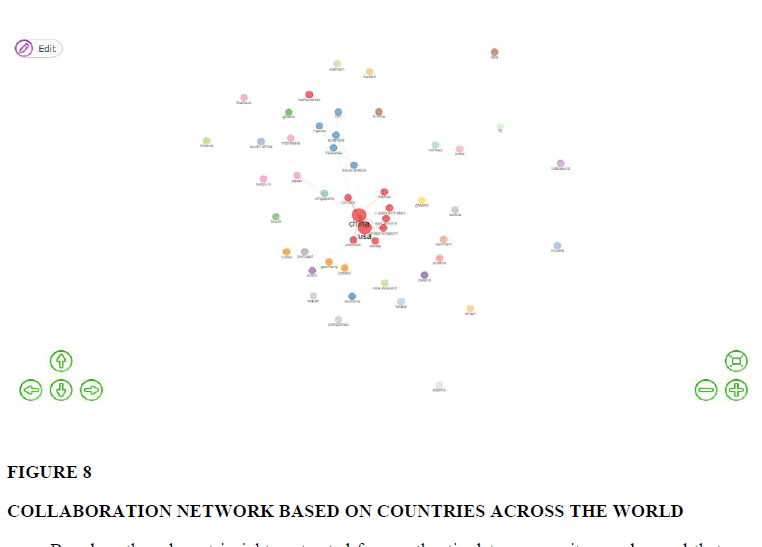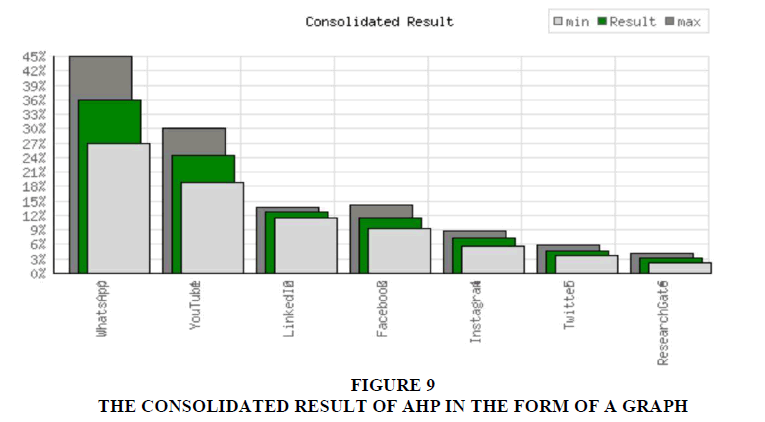Review Article: 2022 Vol: 26 Issue: 3
A Study on Social Networking Platforms In Higher Education Institutions
Sarthak Sengupta, Indian Institute of Information Technology
Anurika Vaish, Indian Institute of Information Technology
Citation Information: Sengupta, S., & Vaish, A. (2022). A study on social networking platforms in higher education institutions. Academy of Marketing Studies Journal, 26(3), 1-16.
Abstract
Social media has witnessed an enormous increase in its usage in higher education during the COVID-19 pandemic. The rapid spread of social networking platforms has been observed due to the sudden implementation of online pedagogy for maintaining travel restrictions and social distancing norms. The relevant studies pursued on social networking and higher education were explored. The study was based on primary and secondary data. Subject matter experts were consulted to conduct virtual brainstorming sessions and the Delphi method with the help of social media to get the relevant set of keywords. Various stakeholders were consulted to derive novel findings regarding different perspectives. Further research studies were explored regarding these frequently used social networking platforms in higher education. A primary survey-based questionnaire was also circulated among the stakeholders of higher education institutions during the Coronavirus crisis. The secondary data was collected from leading research databases across the world. All the motivational studies and relevant research papers extracted for this study were explored thoroughly. Various statistical tools and required software were used. The analytical techniques done in the study were bibliometric analysis, year-wise analysis of research publications, citations, word cloud, thematic map, thematic evolution, keywords-based co-occurrence network, country-based publication analysis along with the collaboration network, co-word analysis-based mapping of the conceptual structure using multidimensional scaling technique, and Analytic Hierarchy Process (AHP). It was found that the research studies across the world increased gradually and various countries were pursuing collaborative research in this area. It was also found that WhatsApp, YouTube, LinkedIn, Facebook, Instagram, Twitter, and ResearchGate were the major social networking platforms being used in the higher education institutions of India. It was also witnessed that social media can be very instrumental in the virtual publicity and digital marketing of higher education institutions. Futuristic strategies to develop effective technology acceptance models and information technology-based infrastructures for efficient implementation of online pedagogy can be done in higher education institutions with the help of social networking platforms.
Keywords
Social Networking Platforms, Higher Education, Social Media, COVID-19 Pandemic, Bibliometric Analysis, Analytic Hierarchy Process.
Introduction
Social media has proved to be a boon during the COVID-19 pandemic (Patil et al., 2021). The study attempted to analyze the rapid influx of social networking platforms in higher education institutions. The sudden increase in social media usage occurred due to the travel restrictions during the Coronavirus crisis. The classrooms were suddenly closed and the teaching system was shifted towards online pedagogy, i.e., the e-learning platforms came to the rescue. Higher education institutions around the world are implementing social media platforms in their curriculum but teachers from some developing or underdeveloped countries are still skeptical about accepting its usability (Kaur et al., 2015). Virtually conducted online education has boosted the implementation of e-learning platforms during the COVID-19 pandemic (Sahu et al., 2022).
The novelty of this study is the prioritized ranking of various social networking platforms being used in higher education. Moreover, all research studies were explored across the world to formulate a panoramic view of the current situation. Social media usage has increased among the students drastically during the Coronavirus crisis. All the stakeholders like learners, teachers, etc., felt that meeting virtually was more feasible during such trying times of travel restrictions. Social distancing measures were easily maintained because of these platforms.
This research work has provided crucial excerpts from relevant literature and also attempted to analyze the research studies across the world. Data were collected from all parts of India and subject matter experts across the world. Essential e-services like Google Forms, social networking platforms like Twitter, LinkedIn, Facebook, WhatsApp, etc., and video conferencing services like Zoom, Google Meet, Microsoft Teams, etc., helped a lot in conducting the data collection process. The prioritized ranking of major social networking platforms in higher education institutions was also analyzed in this study. The study provided the review of literature in the next section regarding social media in higher education and various social networking platforms being used by the stakeholders.
Literature Review
The review of the literature was done with the help of research studies pursued on social networking and higher education. Renowned social media platforms like WhatsApp, YouTube, LinkedIn, Facebook, Instagram, Twitter, and ResearchGate were considered in this study. This research domain is gaining huge importance during the Coronavirus crisis due to the new normal of connecting virtually through online platforms like social media.
A sudden surge in social media impact was witnessed during the COVID-19 pandemic due to the forced indulgence in online pedagogy. The new normal has paved the way for the electronic medium as the main mode of communication to maintain the social distancing norms and other precautions. Social media has seen a rapid influx of data which helped generate information for pattern recognition of all types of users. Academicians, researchers, consultants, and decision-makers keep on identifying and formulating plans, ways, and strategies that can make positive and profitable use of social media applications such as LinkedIn, Instagram, YouTube, Second Life, Facebook (renamed as “Meta”), Twitter, etc. Though, Facebook (Meta) and LinkedIn have been found most popular among young professionals among other user brackets. Social networking platforms have become an essential technology in the information society with increasing acceptability and high usability (Dumpit et al, 2017; Manning, 2014; Prandi et al., 2021).
Social networking sites have also become a niche and popular medium for information distribution and facilitators for social interactions. Social media users are increasing seamlessly in higher educational institutions. It has been found that the usage of social media is increasing unprecedentedly in admissions, project management, planning, and managing projects purchasing or procurement of products and services, circulating information regarding recruitment and placements (off or on-campus) along with conducting or joining the hiring processes, sharing or resolving grievances and negotiating conflicts. Additionally, it is being used for circulating, leading, planning, and executing educational events or outreach activities along with the usage of marketing and publicity to ensure branding. Nowadays, it is also used for maintaining public relations and social networking. Social media can be used to strategically manage and execute activities. Nowadays, social media usage has increased radically around the globe because it provides access for universal users to the virtual society even during such travel restrictions and social distancing norms due to the COVID-19 pandemic (Chugh et al., 2021; Hookway, 2008; Lansigan et al., 2016; Manca et al., 2017; Menzies et al., 2017; Zdravkova et al., 2012).
Facebook is a social networking platform used mostly by students and teachers in higher education. A research study critically analyzed the adoption of Facebook for academic purposes (Sharma et al., 2016). WhatsApp can be an effective tool for texting and sharing information regarding academic purposes. The sudden rise in WhatsApp usage has been accelerated due to smartphones (So, 2016). YouTube is an effective social media platform for sharing educational videos and it has been instrumental in teaching students for improving their learning outcomes (Orus et al., 2016). LinkedIn is considered to be a professional social networking platform. It has been extensively used by marketing professionals and educators across the globe (Hutchins, 2016). Instagram is a social networking service for photo or video-sharing and it is being used as an efficient tool for spreading knowledge in higher education (Arceneaux et al., 2018). Twitter is a microblogging platform being used by academicians, researchers, and scholars for educational purposes (Veletsianos, 2011). Twitter is popular among all the stakeholders in higher education and it has huge potential for e-learning pedagogy (Kassens-Noor, 2012). ResearchGate is a social networking site for academic and research purposes. This platform has been instrumental in analyzing the research activities in higher education institutions. It can also be used for the promotion of publications and academic influence among the research fraternity (Yan et al., 2018). The review of literature assisted in finding the research gaps, and questions. The research objectives were also formulated and provided in the next section accordingly.
Methodology
Primary and secondary data were collected. Primary data was collected with the help of questionnaires, virtual brainstorming sessions, and the Delphi method. The respondents and participants were the stakeholders of higher education institutions like students, teachers, administrative officers, staff, and other employees of the institution. External entities like guardians or parents of students, vendors or third parties, government agencies, industries, and sponsored bodies were also taken into account. Google Forms proved to be instrumental while collecting relevant responses. The help of virtual platforms like Zoom, Google Meet, Linkedin, Facebook, Twitter, and WhatsApp ensured proper validation of the set of buzzwords trending throughout the world along with the pilot testing for justification of relevant results. The secondary data was collected from leading research databases like the renowned Clarivate Analytics’ Web of Science, IEEE Xplore, Elsevier’s ScienceDirect, Springer, Google Scholar, and allied business academy publications. But the rigorous analysis was done on the Web of Science dataset because it is considered to be a major database for research articles and bibliometric analysis was suitable for it (Abramo et al., 2015; Conde et al., 2018). The data collected was found to be reliable and ethical. All the motivational studies and relevant research papers extracted for this study were explored thoroughly.
The statistical tools and software used were IBM-SPSS, RStudio, AHP-OS, Microsoft Office, and Google Apps. Bibliometric analysis was done to analyze the research studies done across the world on social networking and higher education. The analytical techniques done in the study were year-wise analysis of research publications, citations, word cloud, thematic map, thematic evolution, keywords-based co-occurrence network, and country-based publication analysis along with the collaboration network. A co-word analysis-based mapping of the conceptual structure using a multidimensional scaling technique. The Analytic Hierarchy Process (AHP) was done to check the priority of the social networking platforms.
The research gaps of the study are as follows: -
1. A very less number of research studies on social networking and higher education have been done in India.
2. A negligible amount of work has been found on the usage of social networking platforms in higher education institutions during the COVID-19 pandemic.
The research questions of the study are as follows: -
1. What is the current situation of research studies on social networking platforms and higher education across the world?
2. Which countries are pursuing research on social networking and higher education?
3. What is the prioritized ranking of major social networking platforms in higher education?
The research objectives of this research study are as follows: -
1. Performing bibliometric analysis to explore the research studies done on social networking and higher education.
2. Analyze the prioritized ranking of major social networking platforms in higher education institutions.
Analysis and Findings
The study has provided the analytical process and crucial findings in the form of sub-sections provided below. The bibliometric analysis and Analytic Hierarchy Process (AHP) were done.
Bibliometric Analysis
The bibliometric analysis comprised of a year-wise analysis of research publications or citations, word cloud, thematic map, thematic evolution, keywords-based co-occurrence network, country-based publication analysis along with the collaboration network, and co-word analysis-based mapping of the conceptual structure using multidimensional scaling technique. The keywords-based search comprised social networking and higher education to extract research articles across the world. So, the search process was carried out with “social networking” as the first keyword along with “higher education” as the second keyword and the operator being used was the AND Boolean gate or operator. The AND Boolean gate-based search was done to take the intersection set of both the keywords. After this process, a total number of 325 research publications were extracted from the Web of Science database. Further analysis was done on the data extracted from the Web of Science core collection with the help of the RStudio software. Figure 1 provided the year-wise analysis of research studies published till 31 March 2022, i.e., till the date of this research study being done. The horizontal axis is denoted in years. The vertical axis is denoted in two parts, i.e., the left part is the number of publications whereas the vertical axis on the right side of the figure denotes citations. The indexing of the color-coding has been provided in Figure 1 itself. It can be observed in the figure that the number of research publications and citations increased during the COVID-19 pandemic. Figure 1 was generated with the help of the Web of Science platform.
Figure 1: Chart Regarding Research Publications Based On The Years V/s no. Of Publications And Citations.
The software R-Studio has a package named Bibliometrix (Aria et al., 2017) which helped in performing bibliometric analysis. The same set of keywords namely social networking and higher education had been used in the Web of Science platform to perform the analysis. A total number of 325 research articles were taken from journals, reviews, conference proceedings, etc., and were explored thoroughly. The extracted data was in the form of BibTex which was suitable as an input file for the Bibliometrix-based Biblioshiny interface. The top 10 relevant words used frequently in the research studies across the world were higher-education, Facebook, university, media, perceptions, students, online, information, social networking, and web 2.0. Figure 2 provided the word cloud. The field chosen was keywords plus, and the number of words was increased to 100. The word occurrence measure was done according to the frequency of the occurrence of the keywords. The shape was selected as a circle with a font size of 1 and ellipticity of 0.65 for viewing the figure in a better way. The co-occurrence network on the basis of the keywords extracted had been depicted in Figure 3. The co-occurrence network was designed by selecting keywords plus as the field setting, network layout being automatic, normalization was set to the type namely association, and the clustering algorithm was set to Louvain. The number of nodes was selected as 50 without removing any isolated nodes. The label size was 4 and the edge size was 5 for viewing the figures in a better way. The figures provided a bird’s eye view of the most important keywords on which the research studies are being done in the area of social networking and higher education. This helped in pursuing further research with the research study. The figures justify the fact that there are plenty of keywords that are being pondered upon and most of the concepts are being explored in collaboration with relevant conceptual keywords.
While creating the thematic map, the field was selected as keyword plus and the number of words was 250. The number of labels for each cluster was kept as 5 while the label size was set to 0.05. The thematic map has been provided in Figure 4. The axis is formulated on the basis of density and centrality. The thematic map has been divided into four quadrants namely the motor themes, niche themes, emerging or declining themes, and basic themes. As expected, some keywords like Facebook and social networking are coming under basic themes. Few keywords like online, information, health, usage, networks, etc., were found in motor themes. Performance, model, college students, etc., were notable keywords of niche themes. Other keywords like social networking sites, higher education, knowledge motivation, etc., were observed in emerging and declining themes. An interesting observation was that some keywords like information technology, acceptance, adoption, community, and technology acceptance model were found in the middle of the two quadrants, i.e., basic themes along with emerging and declining themes. Thematic evolution has been depicted in Figure 5. The same field was kept, i.e., keyword plus for maintaining uniformity. The inclusion index weighted by word occurrences was the type of weight index with the minimum value being 0.1. The label size was 0.5. Only 1 cutting point had been taken with the year being 2019 for exploring the patterns before and during the COVID-19 pandemic. The theme-based keywords in research studies done till the year 2019, i.e., before the pandemic were adjustments, college students, online, social networking sites, higher education, design, information technology, association, students, information, and model. Whereas theme-based keywords in research studies after the year 2019, i.e., during the pandemic were usage, Twitter, system, model, management, impact, online, higher education, performance, information, perceptions, health, and future. These analyses have been done on the basis of the co-words network and clustering (Cobo et al., 2011). The thematic map and evolution also helped in detecting conceptual sub-domains (Chen et al., 2019). Therefore, the figures provided the mapping of the relevant research fields along with the sub-themes and domains.
Thematic Evolution
Further analysis of co-words was done by mapping the conceptual structure of the framework based on the co-occurrences of the words in the bibliographic data extracted. Figure 6 provided the results of the co-word analysis conducted using the multidimensional scaling technique. Multidimensional scaling is a dimensionality reduction technique. The clustering provided in the figure helped in understanding the conceptual structure and documents with common concepts. The results in figure 6 are plotted in a 2-D map and the label size was set to 10. The algorithms used for performing this analysis are natural language processing and Porter’s stemming algorithm (Aria et al., 2017). The results reflect a variety of keywords and concepts to be pondered upon. The points in the red-colored cluster like the classroom, students, attitudes, impact, communities, student perceptions, performance, etc., are related to each other. The blue-colored cluster is comprised of relevant points like information technology, technology acceptance model, user acceptance, and online social networking. The technology acceptance model can be implemented with the help of information technology. The acceptance of the user may be dependent on the usage of social networking platforms.
Figure 6:Co-Word Analysis-Based Map Regarding Conceptual Structure Using Multidimensional Scaling Technique.
The countries pursuing research on social networking and higher education were analyzed along with the help of a country-based collaboration network. Figure 7 provided the graphical representation of the top countries across the world pursuing research on social networking and higher education. The collaboration network based on countries across the world has been provided in Figure 8. The label size was set to 2 whereas the edge size was set to 5. It provided a bird-eye view of the countries pursuing research in the domain along with the network with other countries for collaborative research purposes. It was found that the main countries working in this research area were found to be the USA, China, England, Malaysia, Australia, etc. It was also found that a very less amount of research work has been done in this domain from India. It was also observed that many countries are collaborating to explore further research insights on social networking and higher education.
Figure 7:Bar Chart Representing The Top Countries Pursuing Research On Social Networking And Higher Education.
Based on the relevant insights extracted from authentic data sources it was observed that the major social networking platforms in higher education institutions were WhatsApp, YouTube, LinkedIn, Facebook, Instagram, Twitter, and ResearchGate. So, the search keywords were formulated and entered into the Web of Science database to check the number of research studies done on these social networking platforms in higher education published till March 2022. Table 1 provided the details of these social media platforms along with the number of relevant research studies. The most researched social media sites in higher education were Facebook, Twitter, and YouTube. Researchers are exploring various social networking platforms to understand their impact on higher education. Social media affordances seem to be promising for teaching and learning purposes.
| Table 1 Research Studies On Social Networking Platforms In Higher Education |
|
|---|---|
| SOCIAL NETWORKING PLATFORM | NO. OF RESEARCH STUDIES IN THE WEB OF SCIENCE DATABASE |
| 457 | |
| 273 | |
| YouTube | 92 |
| 51 | |
| ResearchGate | 33 |
| 29 | |
| 22 | |
Analytic Hierarchy Process (AHP)
The Analytic Hierarchy Process (AHP) was done with the help of the AHP-OS tool (Goepel, 2018) after the extraction of the respondents’ feedback on the ranking of various social networking platforms in higher education institutions. The AHP performed the quantitative analysis with the help of the MCDM (multi-criteria decision-making) technique that facilitated the calculation of the priorities and ranking (Leal, 2020). AHP is a relevant technique used extensively (Cronholm et al., 2015). Its implementation helped in assigning weights to various social networking platforms accordingly. This generated a ranking of the social networking platforms and the social media sites could be evaluated in a better way because of the weightage-based priorities. The online tool is an efficient platform to perform Analytic Hierarchy Process. The platforms were analyzed based on secondary and primary data. Delphi method and questionnaire-based survey responses were the primary sources of data whereas the review of the literature was the secondary source. The AHP priority method was used to analyze the criteria’s aspects. The work done in this research study is limited to exploring the priority of social networking platforms with the help of the weighted ranking-based AHP method. A question was incorporated in the survey to get responses regarding the frequency of using various social networking platforms among the stakeholders in higher educational institutions. IBM-SPSS and Microsoft Excel helped in analyzing the responses collected. The primary data extracted with the help of majority-based responses from the experts were inputted accordingly. Google forms helped in collecting 584 responses while conducting the questionnaire-based primary survey. The data was collected from 330 students or research scholars, 155 teachers or faculties, 47 administrative officers or staff or other employees from higher educational institutions, and 52 external entities or others related indirectly to the higher education institutions of India. It was found that there were 369 males (63.2 % of respondents) and 215 females (36.8 % of the respondents). Most of the respondents used social media platforms namely - WhatsApp (96.1% of the respondents), YouTube (81.2% of the respondents), Facebook or Meta (72.1% of the respondents), LinkedIn (66.8% of the respondents), Instagram (65.4% of the respondents), Twitter (33.9% of the respondents), AND ResearchGate (31% of the respondents). It was also found that few respondents used other social networking platforms like Telegram, Snapchat, Reddit, etc. So, there were 7 social networking platforms being used mainly among the stakeholders of higher education. The social media sites were WhatsApp, YouTube, LinkedIn, Facebook, Instagram, Twitter, and ResearchGate. These helped in fulfilling the requirements for computation of the criteria for calculating the AHP priority. The study pondered on finding the weighted ranks of the social networking platforms and not on computing the alternatives. So, there were a total of 21 pair-wise comparisons. The data was inputted on the basis of the responses already collected and further surveys from 177 subject matter experts. The resulting weights were based on the principal eigenvector of the decision matrix given in Table 2. The numbers 1 to 7 that have been given in the decision matrix in Table 2 are basically the social networking platforms whose indexing of numbers has been provided in Table 3.
| Table 2 The Decision Matrix For The Resulting Weights Based On The Principal Eigenvector |
|||||||
|---|---|---|---|---|---|---|---|
| 1 | 2 | 3 | 4 | 5 | 6 | 7 | |
| 1 | 1 | 2 | 3 | 4 | 5 | 6 | 7 |
| 2 | 0.50 | 1 | 2 | 3 | 4 | 5 | 6 |
| 3 | 0.33 | 0.50 | 1 | 1 | 2 | 3 | 4 |
| 4 | 0.25 | 0.33 | 1 | 1 | 2 | 3 | 4 |
| 5 | 0.20 | 0.25 | 0.50 | 0.50 | 1 | 2 | 3 |
| 6 | 0.17 | 0.20 | 0.33 | 0.33 | 0.50 | 1 | 2 |
| 7 | 0.14 | 0.17 | 0.25 | 0.25 | 0.33 | 0.50 | 1 |
The resulting weights for the criteria based on the pairwise comparisons inputted in the tool have been provided in Table 3. This table provides the ranks of various social media usages and their respective priorities. The number of comparisons was 21 because of 7 social networking platforms. The consistency ratio (CR) was found to be 1.9%, i.e., 0.019. The principal eigenvalue was calculated to be 7.15. The eigenvector solution had 4 iterations with delta = 4.4e-8. So, the consolidated result in form of a graph has been depicted in Figure 9. It can be observed that WhatsApp and YouTube had the maximum priority in higher education.
| Table 3 The Resulting Weights For The Criteria Based On The Pairwise Comparisons Along With The Indexed Serial Numbers, Ranks, And Priority For All Social Networking Platforms |
|||||
|---|---|---|---|---|---|
| INDEXED SERIAL NUMBER | SOCIAL NETWORKING PLATFORM | PRIORITY | RANK | (+) | (-) |
| 1 | 36.0% | 1 | 9.0% | 9.0% | |
| 2 | YouTube | 24.5% | 2 | 5.6% | 5.6% |
| 3 | 12.6% | 3 | 1.1% | 1.1% | |
| 4 | 11.6% | 4 | 2.4% | 2.4% | |
| 5 | 7.3% | 5 | 1.6% | 1.6% | |
| 6 | 4.7% | 6 | 1.1% | 1.1% | |
| 7 | ResearchGate | 3.3% | 7 | 1.0% | 1.0% |
Interesting and essential findings were found after conducting this research study. It was observed that the research studies around the globe increased steadily. Moreover, it was found that various countries were pursuing collaborative research in the area of social networking platforms and higher education. It was also found that WhatsApp, YouTube, LinkedIn, Facebook, Instagram, Twitter, and ResearchGate were the major social networking platforms being used in the higher education institutions of India. Various stakeholders were consulted to derive novel findings regarding different perspectives. Further research studies were explored regarding these frequently used social networking platforms in higher education. Social media has been witnessed to be very instrumental in the publicity and digital marketing of higher education institutions. The implications of this study can be helpful for higher education institutions that are planning to implement the effective usage of social networking platforms among the relevant stakeholders.
Social networking platforms can help in generating innovative strategies to enhance higher education. A ranking framework of verified profiles can help in generating novel insights regarding the stakeholder. This can help in the early detection of moods. Moreover, the gradual consequences of the relevant findings can assist in the overall development of higher education institutions. LinkedIn can be a burning example of an effective tool for recruitment and professional purposes. Relevant issues like stalking, conflicts, and cyberbullying are less on LinkedIn than on Facebook or Twitter (Sengupta et al., 2020). For example, if someone stalks a person on Linkedin than a free notification regarding profile visits is provided. A social networking system can be instrumental for the futuristic development of an innovative administrational framework, e-learning management, Artificial Intelligence-based question answering chatbots, machine learning-based smart attendance system, location-based face detection algorithm, and health facilities for various entities in the higher educational atmosphere. The stakeholders can comprise all the relevant clusters like the students, teachers, administrative officers, staff, deans, parents, guardians, alumni, and other entities. Therefore, novel technology acceptance models can be derived based on the new normal occurring due to the COVID-19 pandemic. The Coronavirus crisis has drastically affected mankind but opened up new avenues for innovative technological development of social media for higher educational purposes. Social media has been instrumental in building interpersonal relationships, information dissemination, etc. (Kumar et al., 2021) Social media platforms like Facebook, Instagram, etc., have proved to be an effective digital marketing tool that can connect with consumers and youngsters for publicizing the intended product or services (Duffett, 2015; Felicita et al., 2022). Higher education institutions can improve their placements, enrollment ratio, recruitment, admissions, and visibility by implementing effective social media marketing strategies. This study can be a foundation stone for the future scope of research regarding endemic-oriented social media strategies. Futuristics strategies to develop effective technology acceptance models and information technology-based infrastructures for efficient implementation of online pedagogy can be done in higher education institutions with the help of social networking platforms.
Acknowledgement
The study was supported by the Ministry of Education, India. All the authors equally contributed to this research work.
References
Abramo, G. & D’Angelo, C.A. (2015). An assessment of the first “scientific habilitation” for university appointments in Italy. Econ Polit. 32, 329–357.
Indexed at, Google Scholar, Cross Ref
Arceneaux, P.C. & Dinu, L.F. (2018). The social mediated age of information: Twitter and Instagram as tools for information dissemination in higher education, New Media & Society, Volume 20, Issue 11, pp 4155-4176
Indexed at, Google Scholar, Cross Ref
Aria, M. & Cuccurullo, C. (2017). Bibliometrix: An R-tool for comprehensive science mapping analysis, Journal of Informetrics, 11(4), pp 959-975.
Indexed at, Google Scholar, Cross Ref
Chen, X., Lun, Y., Yan, J. et al. (2019). Discovering thematic change and evolution of utilizing social media for healthcare research. BMC Med Inform DecisMak 19, 50.
Indexed at, Google Scholar, Cross Ref
Chugh, R., Grose, R. & Macht, S. (2021). Social media usage by higher education academics: A scoping review of the literature. Education and Information Technologies, 26, 983–999.
Indexed at, Google Scholar, Cross Ref
Cobo, M., López-Herrera, A.G., Herrera-Viedma, E. & Herrera, F. (2011). An approach for detecting, quantifying, and visualizing the evolution of a research field: A practical application to the Fuzzy Sets Theory field. Journal of Informetrics, Volume 5, Issue 1, PP 146-166.
Indexed at, Google Scholar, Cross Ref
Conde, M.Á., & D. Fonseca. (2018). Information society skills: Is knowledge accessible for all? Part I. Univ Access Inf Soc. 17, 223–227.
Indexed at, Google Scholar, Cross Ref
Cronholm, S., Neubauer, M. & Stary, C. (2015). Guiding situated method transfer in design and evaluation. Univ Access Inf Soc. 14, 151–168.
Indexed at, Google Scholar, Cross Ref
Duffett, R.G. (2015). The influence of Facebook advertising on cognitive attitudes amid Generation Y. Electron Commer Res 15, 243–267.
Indexed at, Google Scholar, Cross Ref
Dumpit, D.Z. & Fernandez, C.J. (2017). Analysis of the use of social media in Higher Education Institutions (HEIs) using the Technology Acceptance Model. Int J Educ Technol High Educ 14, 5.
Indexed at, Google Scholar, Cross Ref
Felicita, R.F, & Shirmila, T. (2022). Repositioning strategies of social media influencing consumer predilection of branded apparels among Chennai youth. Academy of Marketing Studies Journal, 26(2), 1-9.
Indexed at, Google Scholar, Cross Ref
Goepel, K.D. (2018). Implementation of an Online Software Tool for the Analytic Hierarchy Process (AHP-OS). International Journal of the Analytic Hierarchy Process, Vol. 10 Issue 3 2018, pp 469-487.
Indexed at, Google Scholar, Cross Ref
Hookway, N. (2008). ‘Entering the blogosphere’: some strategies for using blogs in social research. Qualitative Research. 8:91–113.
Indexed at, Google Scholar, Cross Ref
Hutchins, A.L. (2016). Beyond resumes: LinkedIn for marketing educators, Journal of Research in Interactive Marketing, Vol. 10 No. 2, pp. 137-147.
Indexed at, Google Scholar, Cross Ref
Kassens-Noor, E. (2012). Twitter as a teaching practice to enhance active and informal learning in higher education: The case of sustainable tweets. Active Learning in Higher Education. Vol 13, Issue 1
Indexed at, Google Scholar, Cross Ref
Kaur, I., Shri, C. & Mital, K.M. (2015). A Flexible Approach Towards Effective Teaching: Use of Social Media by Teachers. Glob J Flex Syst Manag 16, 391–403.
Indexed at, Google Scholar, Cross Ref
Kumar, S., Lim, W.M., Pandey, N. et al. (2021). 20 years of Electronic Commerce research. Electron Commer Res 21, 1–40.
Lansigan, R.R., Moraga, S.D., Batalla, M.Y.C. et al. (2016). School choice considerations and the role of social media as perceived by computing students: Evidence from one University in Manila. Education and Information Technologies, 21, 1249–1268.
Indexed at, Google Scholar, Cross Ref
Leal, J. (2020). AHP-express: A simplified version of the analytical hierarchy process method, MethodsX, Volume 7, 100748.
Indexed at, Google Scholar, Cross Ref
Manca, S. & Ranieri, M. (2017). Networked scholarship and motivations for social media use in scholarly communication. International Review of Research in Open and Distributed Learning, 18(2).
Indexed at, Google Scholar, Cross Ref
Manning, J. (2014). Definition and classes of Social Media. In K. Harvey (Ed.), Encyclopedia of social media and politics (pp. 1158-1162). Thousand Oaks, CA: Sage.
Orús, C., Barlés, M.J, Belanche, D., Casaló, L., Fraj, E. & Gurrea, R. (2016). The effects of learner-generated videos for YouTube on learning outcomes and satisfaction, Computers & Education, Volume 95, Pages 254-269, ISSN 0360-1315
Indexed at, Google Scholar, Cross Ref
Patil, V., & Kumar, A. (2021). A Viewpoint on Digital Marketing and Usage of Social Media Tools during Covid-19 Pandemic. Academy of Marketing Studies Journal. Vol: 25 Issue: 2S
Sahu, S.K., & Sekhar, S.C. (2022). Perceptive on online education in enabling digital learning. Academy of Marketing Studies Journal, 26(2), 1-7.
Sengupta, S. & Vaish, A. (2020). Social networking mood recognition algorithm for conflict detection and management of Indian educational institutions. Soc. Netw. Anal. Min. 10, 89
Indexed at, Google Scholar, Cross Ref
Sharma, S., Joshi, A. & Sharma, H. (2016). A multi-analytical approach to predict the Facebook usage in higher education, Computers in Human Behavior, Volume 55, Part A, Pages 340-353
Indexed at, Google Scholar, Cross Ref
Veletsianos, G. (2011). Higher education scholars' participation and practices on Twitter. Journal of Computer Assisted Learning, 28: 336-349.
Indexed at, Google Scholar, Cross Ref
Yan, W. & Zhang, Y. (2018). Research universities on the ResearchGate social networking site: An examination of institutional differences, research activity level, and social networks formed, Journal of Informetrics, Volume 12, Issue 1, Pages 385-400, ISSN 1751-1577
Indexed at, Google Scholar, Cross Ref
Received: 08-Mar-2022, Manuscript No. AMSJ-22-11749; Editor assigned: 10-Mar-2022, PreQC No. AMSJ-22-11749(PQ); Reviewed: 24-Mar-2022, QC No. AMSJ-22-11749; Revised: 26-Mar-2022, Manuscript No. AMSJ-22-11749(R); Published: 29-Mar-2022
